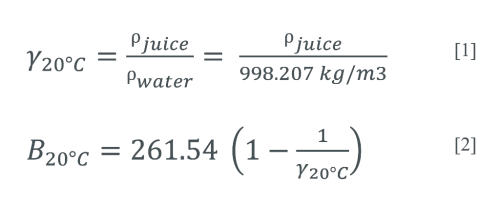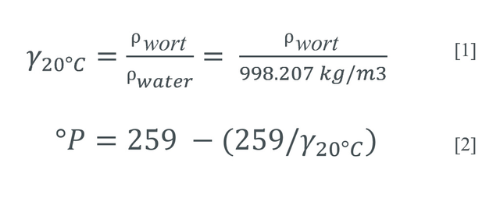- PI sanitary pressure transmitter
- Applications
Pressure and hydrostatic pressure applications
Tank level / hydrostatic pressure
Pressure is a very common way of measuring level in sanitary tanks. The main advantages of using hydrostatic pressure are that it is very tolerant of foam or turbulence in the tank that can cause issues for other top-down measurements, it can accommodate any size tank, and it can be used with almost any liquid media. Alternatively, it’s not a good solution for dry media or solids, it can be influenced by quick changes in temperature, and the level measurement is density dependent.
Where pressure is a good solution the ifm PI1 provides very accurate high-resolution measurements that allow you to monitor tank level very accurately and repeatably. This increases equipment availability as you can rely on the level measurements and prevents overfilling or low level applications which cause small stops that impact process performance.
Use case - tank level with foamy media
Measuring level in tanks with varying levels of foam on top of the media surface is one of the hardest application criteria to manage. Most top down measurements rely on a stable media surface to achieve reliable measurements and foam can easily degrade signal strength or cause inaccurate measurements.
Hydrostatic pressure is optimal in such applications as the foam on top of the media has little to no influence on the hydrostatic fluid column and corresponding level measurement. This eliminates false measurements and signal loss increasing machine performance and availability.
Line pressure
Pressure gauges and sensors are used to monitor line pressure in various sanitary applications. ifm offers a solid-state sensor with a direct pressure measurement and a display providing the best of both worlds. The ifm PI1 sanitary pressure sensor measures and communicates pressure digitally, but also has a bright LED display so pressure values can be easily seen locally.
Additionally, the direct pressure measurement with a ceramic capacitive measuring cell eliminates the need for the fill fluid used with traditional diaphragm sensors. This sensing technology not only prevents potential product contamination, maintaining product quality, but also withstands pressure spikes common in line pressure applications with fast changing valves, reducing unplanned downtime and keeping your equipment available.
Use case - pressure in lines with water hammer (surges)
Continuous processes with fast acting valves are common in food in beverage when moving process fluids, and these quick diversions or stops in fluid flow often create pressure spikes (i.e. water hammer) that can damage equipment and instrumentation.
The ceramic capacitive measuring cell of the PI1 series pressure sensor is very robust due to the cell construction and internal support system, which provide very high over pressure ratings allowing it to handle these pressure spikes without permanent damage. This keeps your process running and increases machine availability.
Pressurized tanks
Pressurized tanks are often found in food and beverage applications for blanketing and carbonating along with many other applications. In these applications the tanks have a pressure above or below atmospheric pressure, which influences the hydrostatic pressure column. In order to get a true level measurement, the application therefore requires two pressure sensors to measure both the pressure of the gas (P2) and the total pressure (P1) of the combined gas plus liquid column pressure. Simple math (Pt = P1 – P2) can then be used to calculate the differential pressure and the level of the liquid media.
The advantage of using hydrostatic pressure in this application is that most likely you need to control the head pressure anyways, so one pressure sensor is already needed. If that pressure is not controlled or monitored, then a single pressure independent level solution like unguided or guided wave radar is a solution.
Use case - bright beer tanks with nitrogen blanket
In applications where it’s critical to prevent oxidation, an inert gas like nitrogen is often used to blanket the product to prevent contact with oxygen. This is the case in bright tanks where finished beer is stored with a nitrogen blanket to preserve flavor and quality characteristics. The difficulty with measuring hydrostatic level in pressurized tanks is that the head pressure on top of the media must also be measured, as it adds to the pressure of the fluid column and two pressure sensors must then be used. In this scenario it’s very important to have high accuracy and high resolution sensors as the actual level measurement is sometimes a small percentage of the overall pressure measurement at the bottom of the tank.
The PI1 series pressure sensors with high accuracy and high digital or analog resolution provides adequate data to perform necessary differential calculations and properly control your process. The reason why high sensor performance is important is because relying on two pressure sensors introduces more error and you therefore need each measurement point to be more accurate with more resolution to achieve a better calculated result.
Tanks with spray balls
Automated cleaning of the inside of tanks with spray balls is used in combination to CIP cycles to reduce or eliminate manual cleaning processes. In order to make this process as automated and efficient as possible the Clean in Place (CIP) process uses instruments that remain installed on the equipment versus Clean out of Place (COP) where instruments are removed from the equipment for cleaning. CIP by nature eliminates the need to remove and re-install instruments after every cleaning cycle, which increases process performance. It also requires instruments that can withstand the high-pressure washdown and the direct water jets from spray balls is often powerful enough to damage some instrumentation.
The ifm PI1 uses a robust ceramic based measuring cell that can handle the direct spray which keeps your equipment available. In comparison, fragile metal diaphragm sensors cannot withstand direct spray from water jets and will either fail or have an offset when the thin metal diaphragm is damaged, consequently reducing machine availability.
Use case - fermentation tanks
Tanks in processes such as cooking and fermentation are prone to leave residue or build-up of media in tanks. Spray balls are often used alongside the traditional CIP process to add a high-pressure wash to the inside of the tank to help remove leftover residue. This creates a challenging environment tank instrumentation as it is left in place during the cleaning process.
The PI1 series pressure sensor can withstand the direct high-pressure spray from water jets and spray balls due to ceramic capacitive measuring cell. It’s much harder and stronger than traditional metal diaphragms which can easily be dented and permanently damaged in these applications. The PI1 series sensor from ifm will reduce instrument failures, prevent unplanned downtime, and maintain performance after the cleaning operation allowing for a higher process performance and machine availability.
Density measurement
Pressure is a measurement of force per area such as pounds force per square inch (i.e. psi). Hydrostatic pressure is a measurement of the force per area exerted by a column of fluid. The static fluid pressure does not depend on the shape, total mass, or surface area of the liquid. It is only a function of the height of the fluid column, the density of the fluid, and the force of gravity.

| P = hydrostatic pressure m = mass (ρ*V) g = force of gravity |
ρ = density of the fluid V = volume (h*A) h = height of the fluid |
Hydrostatic level measurements are therefore density dependent, which means that the density or Specific Gravity (γ ) of the media will influence the force exerted by the fluid column and the level measured by the pressure sensor. If the height of the fluid column is known you can then use the pressure measurement to calculate the density. You can do this easily by using two pressure sensors with a known height between them. The differential between the two sensors (ΔP = PBottom – PTop) provides the force exerted by the fluid column. This pressure can then be used to calculate density using the above equation (ρmedia = ΔP /gh) when the height is known.
Use case - brix calculation in wine fermentation tank
The process of fermentation in winemaking turns the juice from the grapes into the wine we enjoy. During this process yeasts convert the sugars in the juice into ethanol, which reduces the amount of dissolved sugars and as well as density of the media. Degrees Brix is the measurement most commonly used in winemaking, and it is a measurement of the dissolved sugar content in an aqueous solution. Using two pressure sensors at a fixed height apart from each other we can continuously monitor density which can be used to calculate Specific Gravity (γ ) or degrees Brix (B) (see Density Measurement application) using the below equations.

Continuously monitoring the changes in density, or Brix, during fermentation provides valuable process data which can be used ensure fermentation is behaving normally or identify problem fermentations. This information leads to improved process quality and performance versus manual or handheld methods.
Use case - Specific gravity and Plato calculation in beer fermentation tank
The fermentation process in beermaking turns the wort from brewing into beer. Typically, yeast is pitched into the chilled wort which starts the fermentation process. During the fermentation process yeast consume the dissolved sugar in the wort and convert it into ethanol alcohol and cardon dioxide. The amount dissolved fermentable sugars is what determines the amount of alcohol that will be in the final beer. This is typically referred to Original Gravity (OG) and Final Gravity (FG) of the beer, where the original higher density wort is converted to a lower density beer as the sugars are converted into alcohol.
Using two high resolution PI17 pressure sensors from ifm at a fixed height apart from each other, we can continuously monitor density of the beer in real-time. The density measurement can be used to calculate Specific Gravity (γ ) or degrees Plato (°P) using the below equations. See above “Density measurement” application for more information on hydrostatic pressure and density.

Continuously monitoring the changes in density, or Plato, during fermentation provides valuable insight into the brewing process. Real--time data and ifm moneo dashboards eliminate manual sampling and handheld density measurements allowing you focus on making beer. The higher sampling rate also allows you to ensure fermentation is behaving normally, identify problem fermentations, and step-in when needed. More and better information on fermentation improves process performance and ensures beer quality over manual monitoring methods.